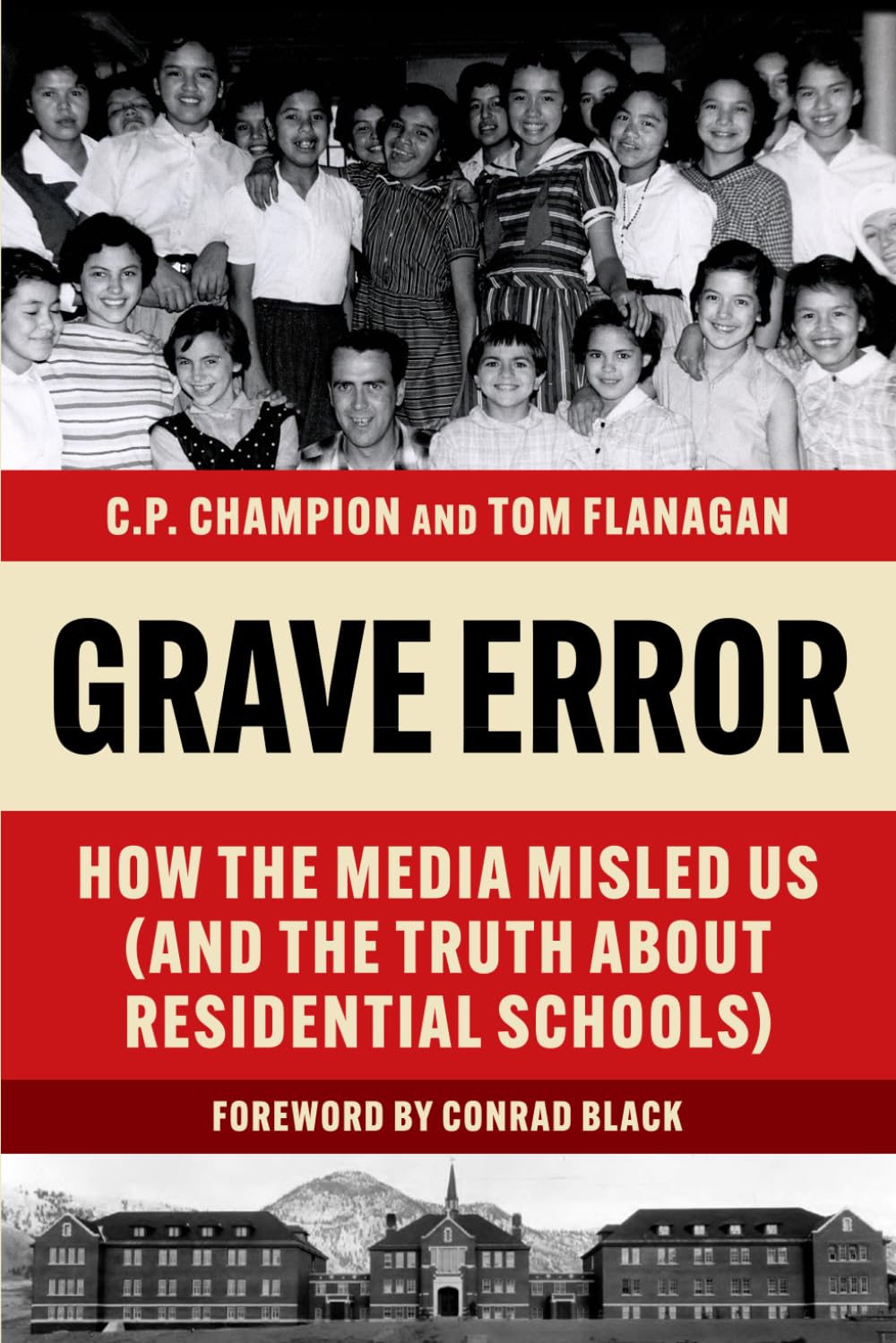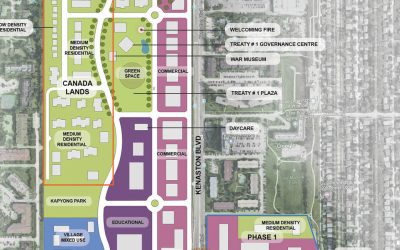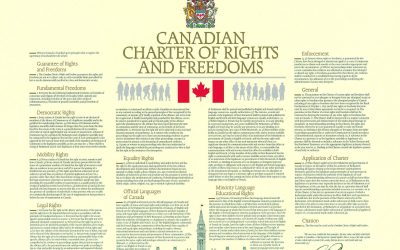Grave Error: How The Media Misled Us (and the Truth about Residential Schools) edited by C.P. Champion and Tom Flanagan, Truth North and Dorchester Review, 343pp, $21.99) is a companion volume to Frontier’s From Truth Comes Reconciliation, which was published in 2021 (second edition is forthcoming). The two reviews published here are by Peter Best and Colin Alexander. The book demonstrates that there is no forensic evidence of Indian Residential School children that have been murdered and buried in residential school yards. There are a number of reasons for not believing the claim that children were murdered in these schools. Canadians are anxious to know the truth about the schools, and this book along with Frontier’s book go a long way to dispel the myths that have developed about the murder of residential school children. The book has been a top seller on Amazon since it was published in early January 2024.
“Ideology functions as a machine to destroy information, even at the price of making assertions in clear contradiction of the evidence.” — Clive James
In October of 2022, members of the Canadian Parliament gave unanimous consent to a motion calling on the federal government to recognize Canada’s Indian residential schools as a form of genocide. Leah Gazan, the NDP member who introduced the motion, told the House:
Today I lift up survivors, families, and communities who have sacrificed so much in order for people across Canada to know the truth; that what happened in residential schools was a genocide. I’m grateful to parliamentarians who unanimously passed my motion recognizing the truth of Canada’s history.
Never has a false and near-treasonous libel against Canada and the churches that managed most of the residential schools been so recklessly made by our political leaders. Never has such a libel been so indifferently reported by the legacy media and so disgracefully supported by the academic and judicial elites.
Consequently, Canadians will probably be surprised to hear that there is no truth to the resolution. To date, there is no forensic evidence supporting the notion that Indigenous children were murdered, and their bodies buried unceremoniously in residential schoolyards.
By the middle of the 19 century the pre-contact Indigenous culture was collapsing, and residential schools were determined to be necessary for providing education for Indigenous children. But only about one-third of eligible children ever attended them, most often for fewer than five years, and attendance was voluntary because parents had to apply in writing for their children to attend.
The death of students did occur, most often in the distant past and most often caused by diseases like tuberculosis that were ravaging families across Canada. Each death was meticulously accounted for because Indian Affairs paid the religious organizations managing the schools per capita grants. If students were missing, school inspectors or Indian Agents would report the missing children to Indian Affairs which would adjust the grants accordingly.
The work of a small group of Canadian researchers has shown that, to date, there are no missing or murdered residential school students.
The purpose of these schools, and of Canada’s 150-year assimilation policy towards Indigenous peoples was not to eliminate them or extinguish their cultures, but to save both.
This genocide lie is a betrayal conducted by the privileged Canadian Indigenous and non-Indigenous elites against the ordinary Indigenous and non-Indigenous people of Canada. This betrayal is the subject of Grave Error- How the Media Misled Us (and the Truth About Residential Schools), a trenchant collection of scholarly essays revealing the truths about Canada’s complex historical relations with its Indigenous peoples and residential schools. Grave Error is edited by Dr. C.P. Champion, editor of the Dorchester Review, and Dr. Tom Flanagan, professor emeritus at the University of Calgary.
In their Introduction, Champion and Flanagan point out that “cultural genocide” is a misleadingly “emotive term for assimilation or integration of an ethnic minority into an encompassing society,” which, in fact, is a positive and historically normal primal force driving human progress and cultural dynamism. They describe the phrase’s origin in the flawed Truth and Reconciliation Report (TRC) and its later emergence in the claims about “missing children, unmarked burials, and mass graves.” Now, there is also Papal approval.
Grave Error correctly reports that the only truth that has resulted from the investigations of residential schoolyards is that our elites have allowed a groundless moral panic to be created in normal Canadians. Grave Error, with its appeal to rationality and facts, bravely tries to quell this panic.
The highly representative essay, In Kamloops, Not One Body Has Been Found, by Professor Jacques Rouillard, professor emeritus of history at the University of Montreal, places responsibility squarely at the feet of the Kamloops band leaders, whose falsehoods were endorsed by the Canadian taxpayer-funded Assembly of First Nations, our politicians, academics, and legacy media, for the church burnings, toppling of statues, lowering of flags, and the International Criminal Court complaint, that followed shortly after the announcement of the discovery “of the remains of 215 children who were students at the Kamloops Residential School.”
Also, he condemns Simon Fraser University (SFU) for allowing a junior Anthropology professor to use ground penetrating radar (GPR) to say that she had discovered unmarked graves, and more seriously, he condemns SFU for refusing to release the GPR report so it can be examined by others.
He also condemns politicians for supporting the claim with no evidence. B. C. Premier Horgan said he was “horrified and heartbroken,” and Canada’s Prime Minister, Justin Trudeau, said that the church burnings were “fully understandable, given the shameful history that we are all becoming aware of.” Some of the churches that were burnt had not been involved in managing Indian residential schools.
Following the improper interference in the RCMP’s investigation of the Kamloops claim by the former TRC Chairperson, Murray Sinclair, the RCMP suddenly decided to stop investigating the claims even though a few of the alleged perpetrators were still alive and could be charged and, if guilty, they could be convicted. In doing this, the former Judge and Senator gave credence to the hoax and its coverup.
The RCMP’s reasoning for suddenly ending the murder investigation, was that it was important for the Kamloops band to conduct the investigation. Professor Rouillard commented that “this approach raises concerns about the RCMP’s abdication of its duties as a national police force…. Will political parties or even biker organizations be the next non-police entities to investigate for themselves?”
Professor Rouillard explains how, taking advantage of the moral panic, the Indigenous-obsessed Trudeau government reversed its long-standing legal position that loss of culture and language was not a legally compensable loss. The government settled the residential school “day scholars” class action lawsuit, compensating Indigenous children who were educated at a residential school but who went home to their own homes after each school day.
As Professor Rouillard wrote:
To teach Indigenous children the public-school curriculum taught to other Canadians, it transpires, was wrong. Teaching Indigenous children how to speak, read, and write in English or French, and how to use numbers, conflicted with Aboriginal values. Ottawa’s reversal implies, as stipulated by Aboriginal leaders, that it would have been better to keep young Natives illiterate.
An informative section of Professor Rouillard’s article relates to the caring and heroic work that the Roman Catholic Oblates of Mary Immaculate performed in educating Indigenous children, and, at the same time, trying their best to help them preserve their cultures and languages. The Roman Catholic orders oversaw 62 residential schools, and often learned the Indigenous languages to better serve the people. Their publications in Native languages “were predicated on the notion that highlighting positive aspects of Indigenous culture would ease the transition to modern society.”
Their official logs and chronicles, kept year by year, were accounts of the goings on in the residential schools: arrivals, departures, illnesses, deaths, recreational activities, student successes, and much more. As Professor Rouillard notes, these records have been shamefully ignored by the Truth and Reconciliation Commission and by Indigenous elites since then, probably because they counter the lucrative “horror stories” narrative of the TRC Report and the legacy media.
Retired University of Manitoba Professor Hymie Rubenstein’s article, Digging for the Truth about Canada’s Residential School Graves, highlights academia’s increasingly counter-productive and illiberal involvement in this issue, quoting Beverly Jacobs, a University of Windsor law professor who said that “any church or government in Canada involved with the residential school system [should] be immediately charged with genocide by the International Criminal Court.”
Importantly, Professor Rubenstein grants public recognition to the extensive and heroic research by Nina Green, who has found death certificates from government records for hundreds of students who died, only a few of whom died in the schools, thus largely questioning, if not disproving the claim that children are “missing.” Evidencing that our elites are not interested in the truth, Professor Rubenstein wrote:
Green communicated all these data long ago to the relevant parties: the media, provincial and federal politicians, Indigenous leaders and activists, and academics focusing on Aboriginal issues. Only a couple bothered to acknowledge receipt of this critical material.
Professor Rubenstein’s summarizes the situation in the following words:
The whole IRS (Indian Residential School) student burial issue has been exaggerated beyond belief by the following parties: lazy, shock journalism reporters, including those employed by the CBC; rent-seeking Indigenous leaders…addicted Indigenous advisors, consultants, and lawyers seeking their share of the rent; “woke” humanities and social science academics; and compliant politicians using virtue signalling rather than concrete policies to solve the myriad of Aboriginal adversities and pathologies.
Professor Frances Widdowson was recently fired from Mount Royal University (MRU) for challenging the validity of the subjective, anti-Enlightenment, alleged “Knowing” of Indigenous “Knowledge Keepers,” and questioning the concept of “Indigenization” of universities. In her article, Billie Remembers, she shows the anti-intellectual charlatanism of her former colleagues at MRU, and the rent-seeking nature of a large part of “Indigenous Industry, that relies upon characterizing Canada as a perpetrator of genocide.”
Writers James Pew and Jonathan Kay, the latter of whom initially believed the Kamloops hoax, try to explain how and why the legacy media failed Canadians. Mr. Pew says that “the opportunity to perform virtue through self-loathing is too tempting for many to resist.”
But it is the obligation of professional journalists to, in fact, resist the temptation to lazily fall into line with a popular narrative that is merely asserted but not proven. They have an obligation to dig and get at the truth, however unpopular it may be.
Jonathan Kay, in his article A Media-Fuelled Social Panic Over Unmarked Graves, attributes the spectacular failure of the legacy media to “the herd behaviour of Canada’s intellectual class.”
Worse, as Mr. Kay points out, now that the truth is known, “no single media outlet has any interest in walking back its previously published misinformation.” Again, coverup is preferred over truth. Admitting mistakes is, in fact, fundamental to generating and keeping trust with the media’s audiences. Consequently, Canadians are losing faith in the mainstream media’s integrity.
In saying the obvious, Clive James wrote: “Even the most fleeting piece of journalism should be written as if the writer might need to defend it on the day of judgement–and for any craftsman proud of his work, the day of judgement is always today.”
Michael Melanson, in his article The Banality of Genocide, made in Canada, focussing on the requirement of intent to prove genocide, demolishes the notion that any aspect of residential schools was genocidal. Mr. Melanson’s arguments on the absence of evidence of a genocide in Canadian residential schools are supported by distinguished Vancouver lawyer D. Barry Kirkham’s article, Neither Truth nor Reconciliation, a thorough deconstruction of the TRC Report. This article is a review of a book that should be regarded as a companion to Grave Error, From Truth Comes Reconciliation: Assessing the Truth and Reconciliation Report, edited by Rodney Clifton and Mark DeWolf, a book that was the first to shed light on the many shortcomings of the TRC Report and the many positives of residential schools.
Throughout Canadian history the Canadian intent towards Indigenous peoples has been liberal, conscientious, and ameliorative. This is convincingly shown in articles by Pim Wiebel and Professors Ian Gentles, and Rodney A. Clifton, which put positive flesh and bones onto the day-to-day experiences of residential school students and employees.
Our elites have wilfully driven Canadians away from the truths revealed in Grave Error. In so doing they have betrayed us, divided us, and harmed our country. As the editors of Grave Error write in the conclusion:
The flight from truth makes true reconciliation impossible. Why will Canadians want to extend the hand of friendship to Indigenous people who continue to call them criminals and murderers? Why will Indigenous people want to engage in cooperation with people whom they have been led to regard as criminals and murderers? Recovering a more balanced picture of residential schools, finding the truth, is the only way to genuine reconciliation.
Fortunately, following From Truth Comes Reconciliation, Grave Error continues the lengthy process of unravelling the falsehoods about residential schools perpetrated against the Canadian people by our elites and telling the much more truthful and balanced story.
Canadians who are concerned with this critical issue must read Grave Error- How the Media Misled Us (and the Truth About Residential Schools).
Peter Best is a retired lawyer living in Sudbury, Ontario. He is the author of the book, There Is No Difference- An Argument for the Abolition of the Indian Reserve System and Special Race-based Laws and Entitlements for Canada’s Indians. (thereisnodifferfence.ca). An expanded version of this article can be read at thereisnodifference.ca.



